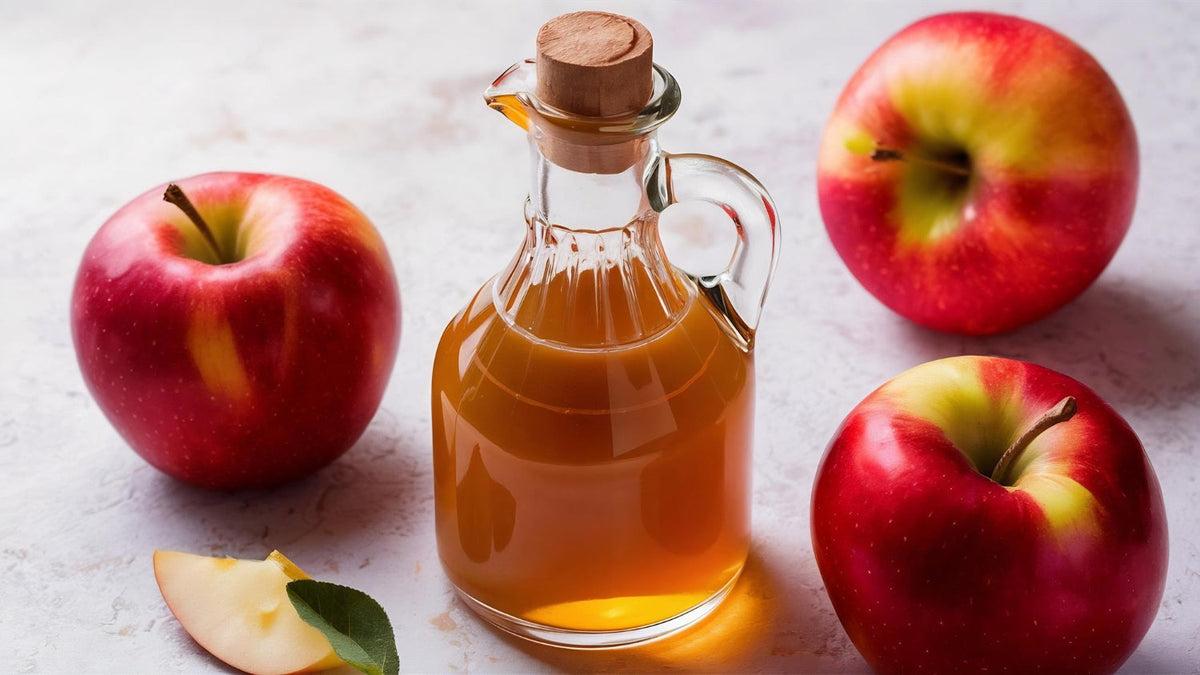Apple Cider Vinegar: Evidence-Based Benefits, Myths & Best Forms (2025 Guide)

What Is Apple Cider Vinegar—and what’s “the Mother”?
Apple cider vinegar is fermented apple juice. Yeast converts sugars to alcohol; acetic-acid bacteria convert alcohol into acetic acid (the molecule behind ACV’s tang and many of its metabolic effects). Unfiltered ACV that lists “with the Mother” contains a visible web of cellulose, bacteria, and metabolites—essentially the living culture and compounds created during fermentation.
| Criteria | With the Mother (Unfiltered) | Filtered / Clear |
|---|---|---|
| What it is | Fermented ACV containing the live culture matrix (“Mother”). | ACV that’s clarified to remove most culture particles. |
| Potential upsides | Traditional Polyphenols Live cultures | Clear taste Uniform color |
| Use cases | Daily tonics, salad dressings, “food as medicine”. | General kitchen use where clarity/taste is preferred. |
| Label cues | “Organic”, “Unfiltered”, “With the Mother”, Acetic acid ≥ 5%. | “Filtered”, “Pasteurised”, typically similar acidity. |
How Apple Cider Vinegar Works
Apple cider vinegar’s main active compound, acetic acid, is what gives it both its sharp flavour and its physiological impact. When taken before or with a meal, acetic acid interacts with digestive enzymes such as amylase, slowing the breakdown of starches into glucose. This delay slightly slows gastric emptying—the rate at which food leaves the stomach—allowing glucose to enter the bloodstream more gradually. The result is a smaller and steadier post-meal rise in blood sugar and insulin, often followed by more stable energy levels over the next few hours.
Beyond glucose regulation, acetic acid has gentle antimicrobial properties, meaning it can inhibit the growth of certain bacteria and yeasts in both food and the digestive tract. This doesn’t sterilise the gut (nor should it), but it can help discourage the overgrowth of opportunistic microbes that thrive on modern, refined diets. The combination of acetic acid, polyphenols, and trace minerals in unfiltered vinegar also supports a more balanced gut environment—one reason many people find ACV soothing after rich or heavy meals.
Some researchers propose that acetic acid may also improve muscle glucose uptake, allowing the body to use carbohydrates more efficiently. While this effect is modest, it reinforces ACV’s reputation as a practical aid for metabolic balance rather than a fad. The takeaway: ACV doesn’t replace healthy eating or exercise, but it can make your existing meals work a little smarter.
Evidence-Based Benefits (and what’s still hype)
Post-meal blood sugar support
Apple cider vinegar’s most reliable effect is on how your body handles carbohydrate-rich meals. The active compound, acetic acid, interacts with digestive enzymes (notably amylase) and modestly slows gastric emptying. Taken shortly before eating—or with the first bites—this shifts glucose entry into the bloodstream from a sharp spike to a gentler slope. Many people interpret that as steadier energy, fewer post-meal slumps, and less of the “hungry again already” rebound. It’s crucial perspective: ACV is not a medication, and it does not replace professional care for diabetes or pre-diabetes. Think of it as a small, mechanical nudge that supports the big levers—balanced meals, fibre, protein, movement, and sleep. Practical pattern: dilute one tablespoon (15 mL) in a large glass of water and sip 10–15 minutes before a starchy meal, or fold it into a starter salad dressing to put acid at the top of the meal. Consistency beats sporadic “mega doses,” and anyone using glucose-lowering medication should check in with a clinician before routine use.
Systematic reviews on vinegar and post-prandial glycaemia Human trials examining acetic acid, gastric emptying, and insulin dynamics
Appetite and weight-management support
Used around meals, ACV can help some people feel satisfied a little sooner and stay full a little longer. Several mechanisms likely contribute: a modest slowing of gastric emptying, a smaller glycaemic rise (which curbs rebound cravings), and the behavioural effect of building a deliberate pre-meal ritual. That doesn’t make ACV a stand-alone “fat-loss solution.” Average effects in studies are modest and depend heavily on diet quality, protein intake, movement, and sleep. Where ACV shines is as a low-friction adjunct to the fundamentals. Pair a diluted tablespoon before higher-carb meals with protein and fibre, and you create more opportunities to eat slightly less without white-knuckling appetite. Capsules are a tooth-friendly alternative if you dislike the taste, but the rules are the same: regular, small, pre-meal doses outperform sporadic large ones. For body-composition change, keep ACV in a supporting role while the leads—calorie awareness, resistance training, daily steps, and adequate sleep—carry the plot.
Clinical studies on vinegar, satiety, and energy intake Reviews of acetic acid’s effects on gastric emptying and appetite signals
Digestive comfort (context matters)
Many people report that a well-diluted ACV tonic before heavy or rich meals leaves them feeling less bloated. A plausible explanation is improved gastric signalling and a nudge toward more efficient digestion when a meal is high in starch or fat; a slightly more acidic environment can also be comfortable for some after legumes or mixed dishes. But digestion is individual. If you have reflux (GERD), active oesophagitis, or enamel sensitivity, acidic drinks can aggravate symptoms. Burning in the chest or throat, hoarseness, or dental discomfort are all cues to stop. In those cases, consider non-acidic strategies for comfort—smaller portions, slower eating, spacing caffeine, and reviewing trigger foods—while you speak with a clinician about tailored options. For everyone else, keep it simple: dilute ACV in plenty of water, sip rather than slam, and avoid bedtime dosing if reflux is a known issue. If discomfort appears, pause and reassess. The goal is gentle support, not a daredevil gut challenge.
Guidance on dietary acids, reflux, and oesophageal irritation Food science reviews on vinegar acidity and digestive tolerance
Skin and hair routines (topical)
Outside the kitchen, ACV appears in DIY routines for scalp and skin. The idea is straightforward: a diluted acidic rinse can help rebalance scalp pH after alkaline shampoos, dissolve product build-up, and discourage yeast associated with flaky patches. On skin, a weak solution may temporarily smooth texture by tightening the outer layer and shifting surface pH. These are cosmetic, practical effects—not cures—and they come with caveats. Never apply undiluted ACV to skin (especially not the face). Patch-test a weak mix (for example, 1:10 ACV to water) on a small area for 24 hours first. Avoid broken skin, mucous membranes, and the eye area entirely. If you have eczema, dermatitis, or a history of sensitivity, consult a professional before experimenting. Stop at the first sign of persistent stinging, redness lasting beyond an hour, or swelling. Treat topical ACV like a periodic clarifying step, not a daily scrub—once or twice weekly is plenty if it agrees with you. Healthy barrier function is the priority; harshness is not proof of benefit.
Dermatology guidance on acids, barrier function, and patch testing
Liquid vs Capsules vs Gummies: which format fits your routine?
Choose ACV like you’d choose footwear: the “best” format is the one you’ll use consistently. Liquids are classic (and versatile in food), while capsules avoid acidity on teeth. Gummies are convenient but can add sugars with lower acetic yield per serve.
| Criteria | Liquid ACV | Capsules / Tablets | Gummies |
|---|---|---|---|
| Typical dose | 1–2 tbsp (15–30 mL) diluted in water | Label-equivalent to ~1 tbsp liquid (varies by brand) | Often lower acetic yield per piece |
| Teeth/enamel | Acidic Use straw + rinse after | Tooth-friendly (bypasses acidity) | Chewable acids + sugars; mindful use |
| Convenience | Great for cooking & dressings | Portable Easy pre-meal | Snack-like; dose may be imprecise |
| Cost per effective dose | Typically lowest | Moderate | Highest |
How to Use Apple Cider Vinegar Safely
Daily amounts
When using apple cider vinegar as a daily support tool, more is not better—consistency and proper dilution matter far more than quantity. Most research uses around one to two tablespoons (15–30 mL) per day of standard 5 % acetic acid vinegar. A good starting point is a single tablespoon diluted in a large glass of water, taken before a starchy meal. If that feels comfortable, you can gradually build up to two tablespoons per day, divided into separate doses (for example, one before lunch and one before dinner). Always listen to your body; if you notice any irritation in your throat, stomach, or teeth, pause or reduce your dose. For capsule forms, choose a reputable brand that specifies its acetic acid equivalence—ideally, each serve should match the acetic yield of roughly one tablespoon of liquid ACV. Avoid “mega-dose” powders or blends that obscure actual acid content, and treat ACV as a small daily habit, not a challenge.
Timing
The most useful timing for ACV is before or with the start of a carbohydrate-heavy meal. Taken 10–15 minutes before eating—or mixed into the first bites—it can slightly slow the digestion of starches and blunt sharp glucose spikes that often lead to post-meal fatigue or cravings. For people with steady blood sugar, the benefit is smoother energy and fewer mid-afternoon crashes. If you’re using ACV for digestion rather than glucose control, the exact timing is less strict—consistency matters more than precision. Evening use is also acceptable, provided it fits your meal schedule; just avoid lying down immediately after consuming acidic drinks if you experience reflux. Whether you take it before lunch, dinner, or both, aim for regular patterns that pair ACV with real food rather than empty stomach dosing. The acid interacts naturally with meal components and causes less irritation when buffered by protein or fibre.
Dilution & dental care
Because ACV is mildly corrosive, dilution is non-negotiable. Always mix one tablespoon with at least a full glass (200–250 mL) of water, herbal tea, or another beverage, or incorporate it into salad dressings and marinades. Never sip it straight—undiluted vinegar can erode tooth enamel, irritate the throat, and upset the stomach lining. When drinking it as a tonic, use a straw to reduce contact with your teeth, and rinse your mouth with plain water afterward. Wait at least 30 minutes before brushing; brushing immediately after acid exposure can worsen enamel wear. Capsules bypass acidity on teeth entirely and are a good option if you already have sensitivity. Glass bottles are preferred for storage—plastic can absorb odour and degrade over time. Finally, treat ACV like a food ingredient, not a medicine: store it at room temperature, seal it tightly, and use it as part of a broader diet built on whole foods, hydration, and balance.
Buyer’s Guide (Australia): what to look for on the label
- Acidity: Look for acetic acid around 5%.
- Clarity: “With the Mother” for traditional unfiltered options.
- Ingredients: Avoid additives or added sugars in basic ACV.
- Packaging: Glass bottles minimise flavour transfer; store cool and dark.
For those who consume ACV daily or in drink routines, bulk cider vinegar options (such as 3.8 L or 5 L bottles) offer far greater value per dose and reduce packaging waste. If storage or space is a concern, decant into smaller bottles. In Australia, look for “with the Mother” labels, 5 % acidity, and certification like Organic or ACO to distinguish premium batches from commodity options like filtered or clear vinegar.
Our Picks: Trusted “With the Mother” Apple Cider Vinegar

Nature’s Goodness ACV Cleansing Tonic — 500 mL
- Ready-to-drink blend—no mixing required.
- Supports consistent daily routines.
- Good entry option for those who dislike plain ACV.

Nature First Apple Cider Vinegar Organic — 500 mL
- Certified-organic apple cider vinegar.
- Balanced flavour profile for cooking and tonics.
- Convenient 500 mL format for first-time ACV users.

Melrose Apple Cider Vinegar Double Strength — 500 mL
- Double-strength formula for smaller volumes.
- Unfiltered with “Mother” for traditional profile.
- Great for experienced ACV users refining dose.
Practical Ways to Use ACV
- Classic tonic: 1 tbsp ACV in a tall glass of water; optional lemon and a touch of honey.
- Pre-meal sip: 1 tbsp diluted 10–15 minutes before a starchy meal.
- Salad dressing: ACV + olive oil + Dijon + salt/pepper; toss through greens or grain bowls.
Apple Cider Vinegar FAQs
What is apple cider vinegar “with the Mother” and is it better?
“With the Mother” means the vinegar is unfiltered and retains the cellulose matrix containing live cultures and fermentation compounds. Many people prefer it for tradition and polyphenols. Filtered ACV can taste cleaner, but both typically have ~5% acetic acid. Choose unfiltered when you want a traditional profile; filtered when clarity and taste matter most.
How much apple cider vinegar should I take per day (dosage)?
A common daily range is 1–2 tablespoons (15–30 mL) of 5% ACV, always diluted. Start with 1 tablespoon in a large glass of water before a starchy meal. If using capsules, select a product that states an acetic-acid equivalent to ~1 tablespoon of liquid ACV. Reduce or stop if you notice throat, dental, or gastric irritation.
How do I dilute apple cider vinegar correctly?
Mix 1 tablespoon (15 mL) of ACV with at least 200–250 mL of water. You can also add it to salad dressings or food to buffer acidity. Avoid drinking ACV straight. Use a straw to limit tooth contact, rinse with plain water afterward, and wait 30 minutes before brushing to protect enamel.
Should I take apple cider vinegar in the morning or at night?
Timing depends on your goal. For post-meal glucose support, take ACV 10–15 minutes before or with the first bites of a carbohydrate-rich meal. Morning is convenient for some routines; evening is fine if dinner is your main carb meal. If you experience reflux, avoid lying down soon after acidic drinks and consider earlier-in-the-day dosing.
Which is better: apple cider vinegar capsules or liquid?
Liquid ACV is versatile and easy to use in food, but it contacts tooth enamel. Capsules bypass acidity on teeth and can be more convenient. The key is acetic-acid yield: choose capsules that specify an equivalence to ~1 tablespoon of liquid ACV. Pick the format you’ll use consistently; consistency beats occasional “mega doses.”
Apple cider vinegar vs white distilled vinegar — what’s the difference?
White distilled vinegar is refined and typically used for cleaning and pickling; it’s sharp, neutral, and often stronger by volume. Apple cider vinegar is fermented from apples, contains acetic acid plus apple-derived compounds, and is intended for culinary use and diluted tonics. For health routines, choose ACV; for household cleaning, use white vinegar.
Can apple cider vinegar help with weight loss?
ACV may modestly support appetite control and reduce post-meal glucose spikes, which can help some people eat a little less without feeling deprived. Results are small and context-dependent. Best results come when ACV complements fundamentals: adequate protein, fibre-rich meals, movement, and sleep. Treat ACV as a helper, not a standalone fat-loss solution.
Does apple cider vinegar lower blood sugar after meals?
Studies suggest diluted ACV before or with a starchy meal can blunt post-prandial glucose rises by slowing gastric emptying and starch digestion. Effects are modest and vary by person. ACV does not replace medical care or prescribed medication. If you use glucose-lowering drugs, consult a clinician before adding ACV regularly.
Is bulk cider vinegar a good idea for regular users?
Yes—bulk cider vinegar offers excellent value per dose and reduces packaging. It suits households making daily tonics and dressings. Ensure it’s ~5% acidity and “with the Mother” if you prefer unfiltered. Decant into smaller bottles for easy use and store sealed, cool, and out of direct light to preserve flavour.
Is pasteurised apple cider vinegar okay, or should I buy unfiltered?
Pasteurised (often filtered) ACV is clear and shelf-stable but lacks “Mother” sediment. Unfiltered ACV retains culture remnants and fermentation compounds. Both typically provide similar acetic-acid percentages. Choose unfiltered for a traditional profile and potential polyphenol content; select pasteurised for taste clarity or if you prefer a sediment-free bottle.
The bottom line
Apple cider vinegar isn’t magic, but it is useful—especially when you apply it with a clear goal and a little structure. The strongest evidence sits around post-meal glucose support and gentle appetite control, both of which work best when ACV is part of a routine you can keep: dilute a tablespoon in water before starchy meals, pair it with protein and fibre, and keep moving daily. If you prefer to avoid acidity on teeth, a well-labelled capsule or a ready-to-drink tonic can deliver similar habits without the tang. For digestion, context matters: if you’re prone to reflux or enamel sensitivity, err on the side of caution, rinse after sipping, and skip ACV altogether if it aggravates symptoms. Consistency beats bravado—there’s no prize for undiluted shots.
From a buyer’s perspective, look for simple quality cues: “with the Mother,” organic where possible, and ~5% acetic acid. Choose a format that matches your life: a pantry bottle for cooking and pre-meal tonics, a double-strength option if you prefer smaller volumes, or a convenience blend to remove friction on busy days. The spotlights in this guide show three clean, well-differentiated paths—everyday, potent, and ready-to-use—so you can start without overthinking it.
Most of all, treat ACV like a small hinge that can swing a bigger door. Use it to steady energy between meals, to nudge appetite in the right direction, and to reinforce the fundamentals you already know move the needle: wholesome meals, sleep, and regular activity. Start low, stay consistent, listen to your body, and let the results accumulate.
About this article
- The Effects of Vinegar/Acetic Acid Intake on Appetite Measures and Energy Consumption: A Systematic Literature Review — National Library of Medicine (Jun 2022)
- Vinegar consumption can attenuate postprandial glucose and insulin responses; a systematic review and meta-analysis of clinical trials — Diabetes Research and Clinical Practice (Elsevier) (May 2017)
-
12 October 2025Notes:Article published


